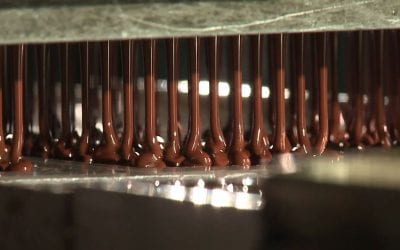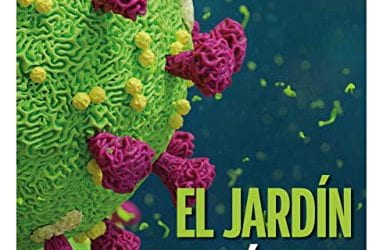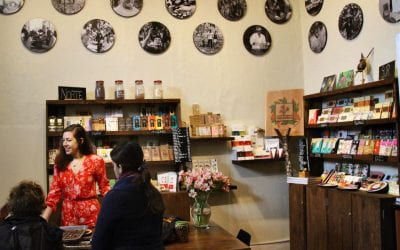Between America and Europe
Cocoa and Chocolate Trade Routes

Depiction of chocolate with molinillo “Chocolatera de cobre, bollo y taza de chocolate” de Luis Méndez. Photo courtesy of Real Museo del Prado Madrid
On Tuesday, September 9, 1645, at 12 noon, the cocoa trader Antonio Méndez Chillón was arrested at his home in Veracruz (New Spain) by the Inquisition commissioner and charged with Jewish heresy. This episode, which was far from being isolated, helps shed some light on the context in which New World commodities found their way to European consumer markets through the intervention of middlemen who, in many cases, belonged to readily identifiable communities.
Much less important, in terms of volume and value, than the export of precious metals or even of such “exotic” products as cane sugar, the cocoa and chocolate trade remained, nonetheless, a constant and representative feature among those items, hitherto unknown, that the discovery and conquest of America brought to the rest of the world.
Whereas chocolate, the thick ritual drink of Mayas and Aztecs elaborated with various ingredients from the processing of dried and roasted cocoa beans, was revealed to Spanish conquistadores from the time of Hernán Cortés’s first expedition in 1519, it was only in 1585 that a first load of cocoa beans from Veracruz was actually mentioned on a bill of lading registered upon arrival in Seville. By then, an important transformation had altered the drink’s original bitter and spicy taste: the addition of cane sugar, now increasingly cultivated in the valleys of Central and Southern New Spain.
Tradition has assigned this initiative to the Carmelite nuns established in the Mexican town of Oaxaca, which bestowed for a time upon the sweetened beverage the name of “Oaxaca delight” (delicia de Oaxaca). The peaceful and secluded environment of convents and monasteries, on both sides of the Atlantic, thus served as appropriate experimental grounds for studying the nutritional and alleged medicinal properties of these New World fruits, while securing a privileged network for their distribution. It is said that the friars of the Cistercian monastery of La Piedra, in Aragon, had been among the first in Spain–supposedly as early as 1530—to savor the taste of chocolate, through a bag of cocoa beans accompanied by a recipe for their preparation sent from New Spain by one of their brethren, friar Jerónimo de Aguilar (1489-1531), shortly before his death. Similarly, as one of the important stops on the pilgrimage route to Santiago de Compostela and capital of one the wealthiest dioceses in Spain, the city of Astorga, in the province of León, numbered many convents and monasteries dedicated to the preparation of chocolate, then redistributed by mule trains towards the rest of the Iberian peninsula.
This “religious distribution network ” also extended internationally. The Franciscan order, which accompanied the conquest and colonization of New Spain, was particularly instrumental in the early introduction of cocoa and chocolate in Umbria, Tuscany and Veneto; and, from there, towards the territories of the Holy Roman Empire and even the faraway shores of the Ottoman empire.
From the end of the 16th century, the Augustinians and, throughout the 17th century, the Jesuits were among the first to promote the cultivation of a high quality variety of cocoa in the southern region of Maracaibo Lake, in western Venezuela, and use its proceeds to contribute to the financing of their schools and missions. In the 18th century, the Jesuits became significant producers of Peruvian cocoa beans and processed cocoa paste, exported by sea from the port town of El Callao towards Cadiz, or by land towards Buenos Aires. In the years preceding their expulsion from the Spanish possessions of the Indies in 1767, they were even accused by the Crown authorities of using the cocoa and chocolate trade as a cover for an even more lucrative smuggling of gold coins and bars, hidden inside the cocoa paste, as the late 19th- and early 20th century writer Ricardo Palma recalled in one of his delightful chronicles about Peruvian traditions [Tradiciones peruanas], serving to illustrate the then popular expression, “heavier on the stomach than Jesuit-made chocolate. ” Similarly, cocoa planters in the Brazilian Amazonia accused the Jesuit missions in the area of disloyal competition, by systematically using their Indian flocks to harvest sylvan cocoa pods in the forest. The planters finally won their case, since in 1757 the king of Portugal José I° decided to secularize the administration of all Brazilian missions, prior to the final expulsion of the Jesuit order from all Portuguese territories in 1759.

Depiction of the Spanish galleons leaving the ports of Cadiz, named “Depart de la flotte du Cadiz a la Vera Cruz” by Armand Joseph Dubernad. Photo courtesy of Musée du Louvre/Château de la Bourdaiserie
Finally, it befell upon the island of Trinidad-based Catalan Capuchin friars, to develop, by the middle of the 18th century, a hybrid cocoa-bean variety still known today as “trinitario,” which was then successfully introduced on the Spanish Main. According to the Prussian naturalist and explorer Alexander von Humboldt, at the turn of the 19th century. more than one million of these “trinitario” cocoa trees were grown in all of eastern Venezuela.
Yet, next to these institutional and—one might even venture to say—“official” cocoa and chocolate routes, a parallel trade network witnessed the intervention of different types of middlemen. A highly speculative commodity, particularly when associated with the use and export of sugar cane, cocoa soon became an important stake in the illicit trade associated with the geopolitical evolution of colonial possessions in the New World. This is where the arrest of Antonio Médez Chillón, mentioned in this article’s opening lines, acquires its full dimension.
The presence of “New Christians,”—Jews converted more of less forcefully to Christianity—is evidenced in the Americas practically from the time of the Columbine voyages, even though they were explicitely forbidden to travel, much less to settle there. Many of these New Christians actually came from Portugal where their presence was somewhat more tolerated than in Spain. But they were universally suspected of secretly practicing their original faith. Many had then found refuge in the Netherlands, freed from Spanish rule at the end of the 16th century. The Dutch occupation of northern Brazil (1630–1654) was a highpoint for this crypto-Jewish presence in America, particularly due to their mastery of cane sugar extracting and processing techniques And it was actually from Brazil that one can trace a sizeable Jewish diaspora from Surinam (which then included part of present-day Guyana) into the Caribbean area. According to Dominican father Jean-Baptiste Labat’s Nouveau voyage aux iles de l’Amerique (New Voyage to the French Isles of America), one Benjamin Da Costa d’Andrade, related to one of the shareholders of the Dutch West Indies Company, was instrumental in introducing, around the 1660s, the cultivation of cocoa on the French island of Martinique, where he also undertook the manufacturing of sugar. By the mid-1680s, Jews virtually controlled the entire cocoa production of the French West Indies which they exported, via Curaçao, to the ports of Bordeaux and Bayonne, on the French Atlantic coast.
The Jewish, or “New Christian,” cocoa and chocolate trade network not only managed to combine a common presence on both sides of the Atlantic—from production areas to consumer markets,— but it also was able to benefit from the thriving illicit trade of cocoa beans originating from the Spanish possessions—a volume of trade at least equivalent to that of “legal” shipments. Actually, by the mid-17th century, Amsterdam, rather than the Iberian peninsula, was the main European center and stock market for the storage and redistribution of these iconic “colonial” wares: cocoa and sugar.
Thus, the arrest and trial in Veracruz of Antonio Méndez Chillón, in 1645, was truly representative of a recurring situation. What the Inquisition authorities were mainly interested in were the suspect’s religious practices, but they had also confiscated his accounting records, duly analyzed a few years ago by U.S. historian Robert J. Ferry, specialist of the Caribbean colonial period, in a ground-breaking article. Not only was Méndez Chillón, according to his confession to the judges of the Holy Office, heavily involved in cocoa bean trafficking, while also dabbling in the Caribbean slave trade, but his profit margin—as estimated by Ferry—well superseded 100 percent, which probably justified all the risks incurred. After a trial lasting nearly two years, the culprit was finally sentenced to deportation back to the Iberian peninsula, while his property was duly confiscated. In view of the fact that he might well have been burnt at the stake, this was a relatively mild sentence.
Fall 2020, Volume XX, Number 1

Gulf of Pria in Venezuela
The need for a better control of commodity trade routes, particularly with regard to cocoa, led colonial powers to favour the establishment of monopolistic companies. In the case of Spain, the heyday for such commercial ventures took place in the 18th century when most of the cocoa trade network originating in the Caribbean region was carried out, with reasonable success, by Basque or Aragonese middlemen. However, one of the last examples of a cocoa network clearly identified with a given community was that of the Corsicans in the Paria peninsula of eastern Venezuela during the 19th- and early 20th centuries.
A decline in agricultural resources, demographic pressure, as well as political or personal circumstances, linked to the problem of military conscription or family vendettas, may help explain the predisposition of these inhabitants of the mountainous regions of the Castagniccia and Cap Corse to leave their native island and seek better fortunes elsewhere. By the early 1820s, a significant Corsican community had emerged in the Spanish island of Puerto Rico, with ramifications in British Trinidad and in the Danish island of St. Thomas. Trade seems to have been its common activity, spurred by the repercussions throughout the Caribbean of the Independence wars on the mainland.
The individual generally credited as being ‘the founding figure’ of the Corsican community in the Paria region was José Vicente Franceschi, who arrived in the port town of Carúpano at age 17, in 1828, and established in 1830 the trading firm of Franceschi & Cia. which served as a rallying point for further arrivals. Though important by the impact it had on local trade, particularly on the cocoa exporting network of eastern Venezuela, the Corsican immigration was not large in actual numbers. A survey completed in 1936 by a French newspaper stated that there were, at that time, around 6,000 Corsicans in all of Venezuela.
Only a limited number of Corsican trading houses managed to control the eastern Venezuela cocoa production and export business at any given time. In 1876, four houses— Franceschi & Cia., Massiani & Cia., Lucca Hermanos and Raffalli Hermanos—accounted for nearly 90 per cent of that year’s cocoa exports. Nearly half a century later, in 1921, five houses —Franceschi & Cia., Prosperi & Cia. (founded in 1890), Antoni Hermanos, Benedetti Hermanos (founded in 1889) and Raffalli Hermanos—still accounted for more than 80 percent of Carúpano’s cocoa foreign trade.
Only the larger among the Carúpano trading firms managed to establish a permanent branch network, both within and outside the Paria cocoa producing area. Franceschi & Cia.—according to the evidence gathered so far—was the only company that also had a representative office in Paris, established in 1876. But all firms, large or small, had their team of purchasing agents who would negotiate directly with the cocoa crop owners. Virtually from the start, the Corsican trading houses became involved in the financing of the cocoa crop, through loans granted to local producers, guaranteed by a property mortgage or on the security of the crop itself. This practice, common to all of Venezuela’s agricultural export economy, would soon place the Paria cocoa grower under the financial control of the region’s trading firms which soon became plantation owners in their own right.

Claudia Franceschi, current head of Casa Franceschi. Photo courtesy of Casa Franceschi
The Great Depression of the1930s abruptly ended the cocoa cycle in eastern Venezuela, as well as the Corsican involvement in its expansion. At the beginning of the 1960s, only the firm of Franceschi & Cia. maintained its activities in Carúpano, the sole survivor of a past seemingly gone forever. Yet, the renewed interest for “great vintage ” single-origin cocoa varieties, developed over the past decades in chocolate consumer countries, successfully enabled the house of Franceschi to resume its cocoa exports, collected from Paria as well as from other cocoa producing regions in Venezuela. Since 2009, a new brand, Franceschi chocolates, is distributed both nationally and abroad. Its bars have been distinguished, on various occasions, by the London-based International Chocolate Awards: a belated tribute to nearly five centuries of community involvement in the cocoa and chocolate trade routes between America, Europe and, eventually, the rest of the world.
Nikita Harwich is Emeritus Professor of Latin American History and Civilization at the University of Paris Nanterre, France. His research interests focus on Latin American commodity trade, foreign investments in Latin America, as well as in the history of ideas and contemporary Latin American historiography.
Related Articles
Chocolate: Editor’s Letter
Is it a confession if someone confesses twice to the same thing? Yes, dear readers, here it comes. I hate chocolate. For years, Visiting Scholars, returning students, loving friends have been bringing me chocolate from Mexico, Colombia, Venezuela, Ecuador, Peru…
El jardín pandémico
English + Español
Imagine the tranquility of a garden. With the aroma of flowers mixed in with the buzzing of bees and the contrast of shady trees against the fierce Paraguayan sun. From the intimacy of a family garden in which daily ritual leads one to water the plants, gather up the dry leaves…
What’s in a Chocolate Boom?
English + Español
Peru has a longstanding reputation for its quality cacao. In the past decade, it has also attracted attention as a craft chocolate hot-spot with a tantalizingly long list of must-try makers. Indeed, from 2015 through 2019, a boom of more than 50 craft chocolate…




